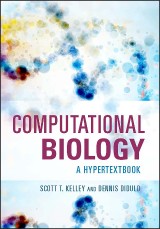Details
Computational Biology
A HypertextbookASM Books 1. Aufl.
|
69,99 € |
|
| Verlag: | ASM Press |
| Format: | EPUB |
| Veröffentl.: | 01.01.2018 |
| ISBN/EAN: | 9781683673033 |
| Sprache: | englisch |
DRM-geschütztes eBook, Sie benötigen z.B. Adobe Digital Editions und eine Adobe ID zum Lesen.
Beschreibungen
<p>This textbook is for anyone who needs to learn the basics of bioinformatics—the use of computational methods to better understand biological systems. <i>Computational Biology</i> covers the principles and applications of the computational methods used to study DNA, RNA, and proteins, including using biological databases such as NCBI and UniProt; performing BLAST, sequence alignments, and structural predictions; and creating phylogenetic trees. It includes a primer that can be used as a jumping off point for learning computer programming for bioinformatics.<br /><br />This text can be used as a self-study guide, as a course focused on computational methods in biology/bioinformatics, or to supplement general courses that touch on topics included within the book. Computational Biology's robust interactive online components “gamify” the study of bioinformatics, allowing the reader to practice randomly generated problems on their own time to build confidence and skill and gain practical real-world experience. The online component also assures that the content being taught is up to date and accurately reflects the ever-changing landscape of bioinformatics web-based programs.</p>
<p>Preface ix</p> <p>For the Instructor xi</p> <p>For the Student xiii</p> <p>Acknowledgments xiv</p> <p>About the Authors xv</p> <p>Chapter –1 Getting Started 1</p> <p><b>Chapter 00 Introduction 5</b></p> <p>Activity 0.1: Biological Databases and Data Storage 20</p> <p><b>Chapter 01 BLAST 31</b></p> <p>Activity 1.1: BLAST Algorithm 36</p> <p><b>Chapter 02 Protein Analysis 47</b></p> <p>Activity 2.1: Hydrophobicity Plotting 52</p> <p>Activity 2.2: Protein Secondary Structure Prediction 58</p> <p><b>Chapter 03 Sequence Alignment 67</b></p> <p>Activity 3.1: Dynamic Programming 74</p> <p><b>Chapter 04 Patterns in the Data 91</b></p> <p>Activity 4.1: Protein Sequence Motifs 94</p> <p>Activity 4.2: Position-Specific Weight Matrices 102</p> <p><b>Chapter 05 RNA Structure Prediction 111</b></p> <p>Activity 5.1: RNA Structure Prediction 118</p> <p><b>Chapter 06 Phylogenetics 133</b></p> <p>Activity 6.1: Phylogenetic Analysis 140</p> <p><b>Chapter 07 Probability: All Mutations are not Equal (-ly Probable) 157</b></p> <p>Activity 7.1: Generating PAM and BLOSUM Substitution Matrices 163</p> <p><b>Chapter 08 Bioinformatics Programming: A Primer 179</b></p> <p>Index 191</p>
<p><b>Scott T. Kelley</b> is a professor of biology at San Diego State University. He received his doctoral degree from the University of Colorado and his bachelor's degree from Cornell University. His lab uses phylogenetic methods and culture-independent molecular tools to study environmental microbiology, and Kelley has published extensively on the human microbiome, built environment, and numerous natural environments. <p><b>Dennis Didulo</b> is a data analytics and software engineer working at Becton, Dickinson and Company. He received his master's degree in information technology at De La Salle University and his second master's degree in bioinformatics at San Diego State University. He has development expertise in more than a dozen computer languages, as well as in database management, algorithm design, and systems engineering.
<p><b>Computational Biology</b> <p>First Edition <p><i>An introduction to the world of bioinformatics</i> <p>Massive increases in computing power and the ability to routinely sequence whole genomes of living organisms have begun to fundamentally alter our understanding of biology, medicine, and agriculture. At the intersection of the growing information and genomics revolutions sits bioinformatics, which uses modern computational power to reveal patterns in biological data sets, especially DNA, RNA, and protein sequences. <p><i>Computational Biology: A Hypertextbook</i>, by Scott Kelley and Dennis Didulo, provides a wonderful introduction for anyone who wants to learn the basics of bioinformatics. This book is more than a textbook because of the wealth of online ancillary materials and how the print and electronic components are integrated to form a complete educational resource. Aspects that make <i>Computational Biology: A Hypertextbook</i> a unique and valuable tool for teaching and learning bioinformatics include <li>Clear explanations of the basic biology of DNA, RNA, and proteins and how the related bioinformatics algorithms work</li> <li>Extensive exercises that enable students to practice with the same bioinformatics applications that are used by scientists worldwide</li> <li>Tutorials, sample data sets, and interactive learning tools developed with teachers in mind and field-tested by hundreds of students</li> <li>Online tutorials and curated web links that are accurate (instead of frustrating!) and won't lead to dead ends</li> <li>Online resources that work on multiple platforms and electronic devices</li> <p><i>Computational Biology: A Hypertextbook</i> is written in an accessible voice, punctuated with humor, and designed to significantly increase computational competencies. Biology and computer science undergraduate and graduate students will thoroughly enjoy learning from this unique hypertextbook, as will anyone with an interest in exploring this burgeoning topic.
Diese Produkte könnten Sie auch interessieren:

Zukunftstechnologie Tissue Engineering

von: Will W. Minuth, Raimund Strehl, Karl Schumacher

114,99 €

Zukunftstechnologie Tissue Engineering

von: Will W. Minuth, Raimund Strehl, Karl Schumacher

114,99 €















